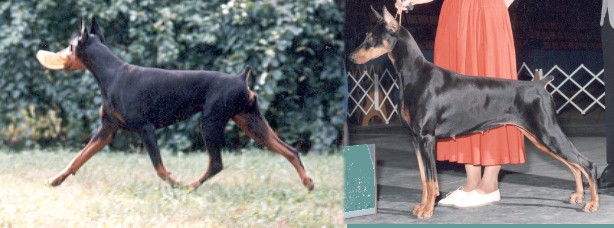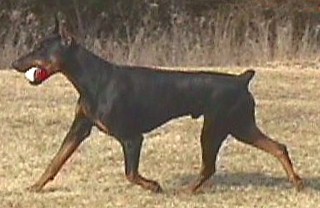Free, balanced, and vigorous, with good reach in the forequarters and good driving power in the hindquarters. When trotting, there is strong rear-action drive. Each rear leg moves in line with the foreleg on the same side. Rear and front legs are thrown neither in nor out. Back remains strong and firm. When moving at a fast trot, a properly built dog will single-track.
Free, balanced and vigorous, with good reach in the front and good driving power in the rear – in the gait, the standard stresses balance. The dog should give you the same impression when it moves as it does when standing — “standing in motion”. Needless to say, the dog that is straight at both ends will move balanced, but may not be correct. You must consider all factors when a dog moves. How does he carry himself, how does the neck fit into the shoulder, is the topline level, where is the tail placement, how does the dog feel about himself (proud carriage, reflecting great nobility, etc)?
Moving away from and toward the judge, the Doberman’s legs should move toward the center. Dobermans single track at different speeds, so the speed of moment in the ring may not be the one that allows the dog to show you that. If the dog is single tracking at a slow speed, chances are very good that if moved a little faster, the legs will cross. How a dog moves toward a center line may be more important than whether it does! An example of a dog moving “straight” coming and going — the rear leg on the right should be moving in the line with the front leg on the right. Joints should also be observed; the dog should move with efficiency with no extra movement of joints (some examples would be flipping feet or loose elbows).
From the side, a Doberman should not move like a German Shepherd. Reach and drive are moderate. A properly build Doberman does not have an extreme gait. It’s quite popular to move the dog as fast as possible, but movement cannot be evaluated when the dog is going so fast. “Speed Kills!” The dog should move at a moderate speed and move on a loose lead so you can actually see movement. The topline should be firm with no dips or bumps, the tail should be out and not up, the neck should be extended with the head forward just above the shoulder. Ears may or may not be erect.
A completely balanced gait is like 2 pairs of scissors opening and closing. The feet do not cross (overreach, over-stride) in the center, but meet. The hock should extend and not be set or stay bent (sickle hocked). The reach in front should extend as far as the plane of the nose. The drive behind should have the rear legs reaching under the dog and propelling him forward — not the rear legs kicking out and up behind, which is wasted energy and provides little forward motion. The front and rear should be in complete balance.
When observing a Doberman gaiting, keep the picture of the general conformation and appearance in mind. This picture should be the same in motion or standing still.
You should get the same impression of the dog when it’s standing or moving.

A completely balanced gait is like 2 pairs of scissors opening and closing. The feet do not cross (overreach) in the center, but meet. When the dog is gaiting, evaluate the topline, how the neck fits into the shoulder, tailset, and how the dog feels about himself.
You should get the same impression of the dog when it’s standing or moving.

Another illustration of a well balanced, powerful side-gait.
As stated above, evaluate the parts of the dog as he gaits, just as you would when he’s standing.

The Doberman is built to be a double suspension galloper (all feet are off the ground at full extension or full contraction). Flexibility and a strong back are important.
Click the following links to read more articles in the “Dobermans in Detail” series: